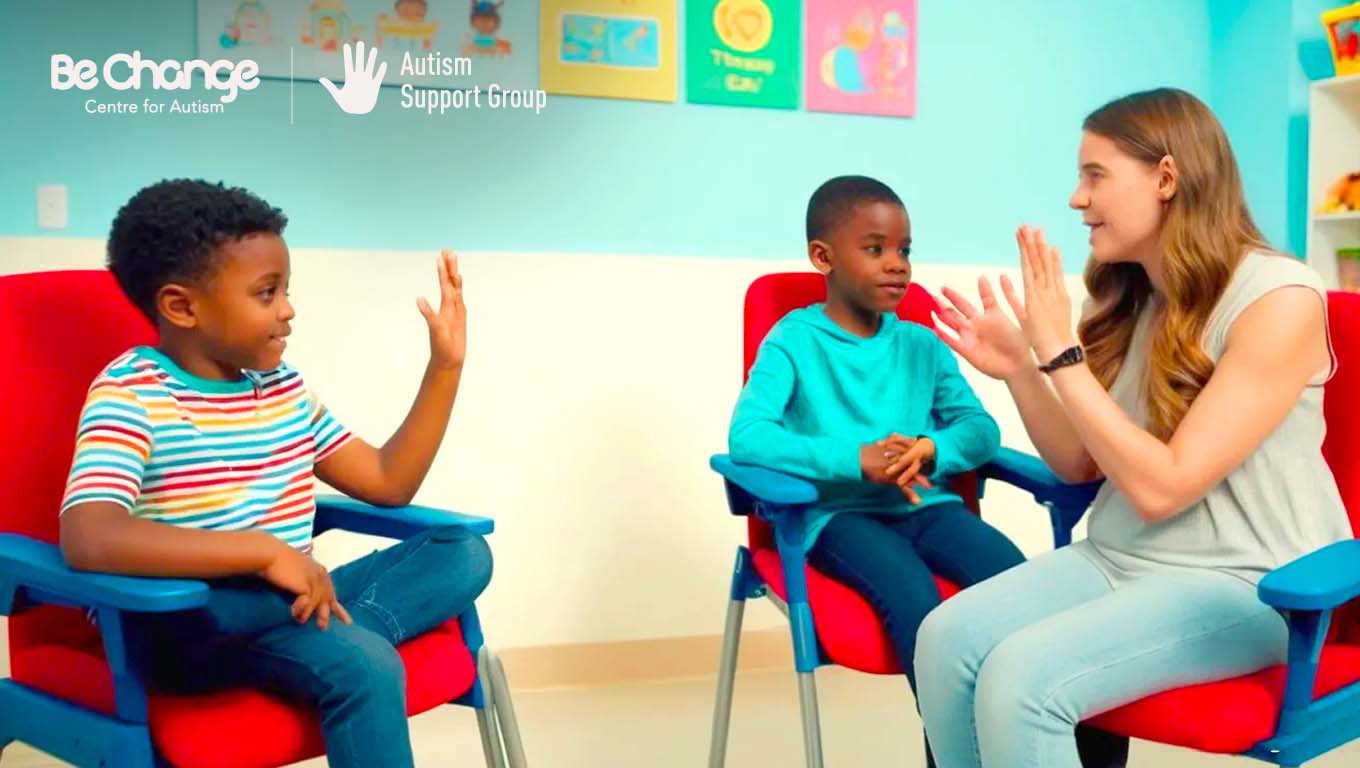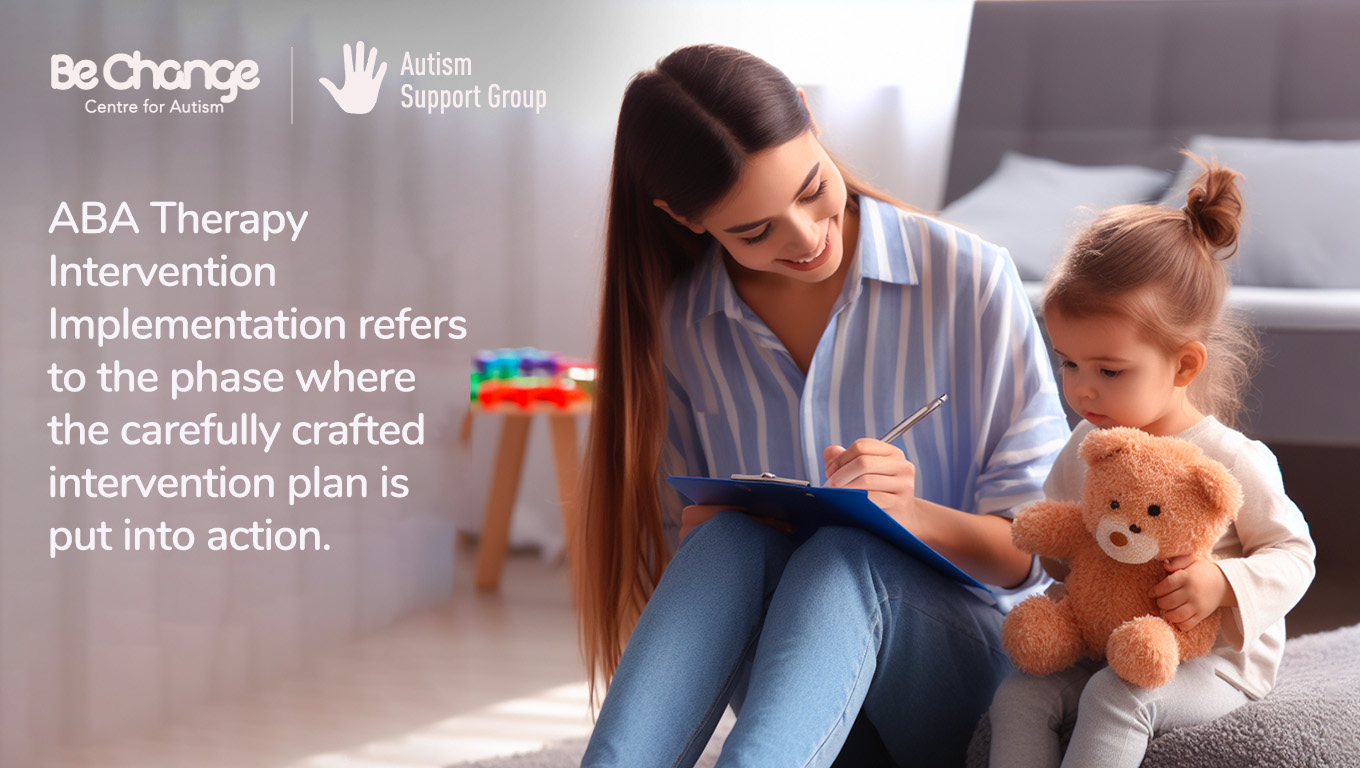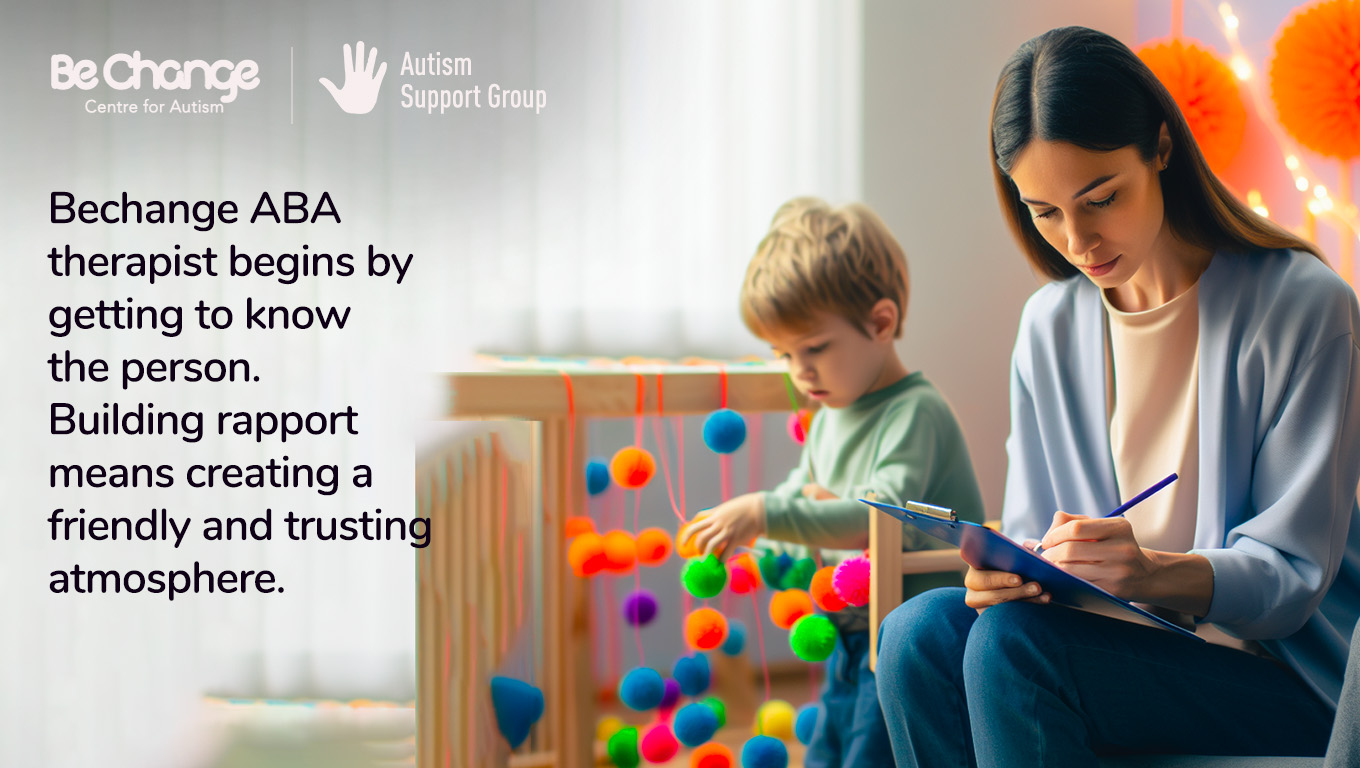What is ABA Therapy ?
 ABA therapy, or Applied Behavior Analysis therapy, is a way of helping people improve their behavior. It’s like a methodical and proven approach that looks at why someone behaves in a certain way and then figures out how to make positive changes.
ABA therapy, or Applied Behavior Analysis therapy, is a way of helping people improve their behavior. It’s like a methodical and proven approach that looks at why someone behaves in a certain way and then figures out how to make positive changes.
Imagine you have a friend who wants to learn a new skill or stop doing something they shouldn’t. ABA therapy is like a friendly guide who watches, understands, and helps them learn or change. This guide uses rewards and encouragement to make sure your friend keeps doing good things and learns new habits.
What makes ABA therapy special is that it’s not the same for everyone. It’s like a personalized plan that fits the unique needs and strengths of each person. So, if your friend needs help, the guide will create a plan just for them.
The cool thing about ABA therapy is that it works for all kinds of people, whether they are kids or adults, and for different challenges they might face. It’s like a flexible tool that can be adjusted to help anyone, no matter their age or situation.
In a nutshell, ABA therapy is a helpful way of changing behaviors by understanding why they happen and using positive reinforcement to encourage better actions. It’s like having a friendly guide who makes a special plan just for you, so you can learn, grow, and improve your behavior.
Autism Support Group : https://www.facebook.com/groups/SupportAutism
These key points will help you to understand ABA Therapy
Core Principles
Basic Ideas Behind ABA Therapy
- Watching and Understanding:
ABA therapy begins by closely observing and trying to comprehend why an individual behaves in certain ways. It involves keen scrutiny, like paying focused attention to unravel the intricacies of their actions and reactions.
- Rewards for Good Behavior:
ABA therapy advocates for the use of rewards or positive reinforcement when a person exhibits desirable behaviors. This method involves acknowledging and praising the individual for their positive actions, creating a motivating environment that encourages the repetition of such behavior.
- Figuring Out Behavior Reasons:
A fundamental aspect of ABA is the meticulous examination of the root causes behind someone’s behavior. It is akin to detective work, seeking to unveil the underlying reasons for actions, thereby gaining a comprehensive understanding to facilitate effective intervention.
- Personalized Plans:
Recognizing the uniqueness of each individual, ABA therapy tailors intervention plans to suit specific needs and strengths. It’s akin to creating a bespoke roadmap, acknowledging that what works for one person may not necessarily work for another.
- Step-by-Step Approach:
ABA therapy employs a systematic, step-by-step approach in fostering positive changes. It’s akin to building a staircase, where each step represents a manageable progression toward behavioral improvement, ensuring a steady and sustainable journey.
- Being Consistent and Dedicated:
Commitment and consistency are paramount in ABA therapy. It involves sticking to the devised plan with unwavering dedication. This steadfast commitment is comparable to nurturing a garden, where regular care and attention yield gradual, positive transformations.
- Using Skills in Different Situations:
ABA aims for the transferability of learned skills across various contexts. It’s akin to mastering a skill in one setting and seamlessly applying it in different situations, fostering a versatile and adaptable behavioral repertoire.
- Clear Communication:
Effective communication is a cornerstone of ABA therapy. It’s akin to ensuring everyone speaks the same language, with therapists, family members, and other stakeholders exchanging information transparently for a unified and comprehensive approach.
- Adapting to Individual Responses:
Recognizing the diversity of individual responses, ABA therapy embraces flexibility. It adjusts strategies based on how a person reacts, acknowledging that a one-size-fits-all approach may not be effective, and tailoring interventions to suit individual needs ensures a more personalized and responsive methodology.
ABA therapy is a comprehensive process that involves keen observation, positive reinforcement, understanding the root causes of behavior, personalized planning, systematic progress, unwavering commitment, skill transferability, clear communication, and adaptability to individual responses. Each of these elements contributes to the effectiveness of ABA therapy in fostering positive changes in behavior.
Read about Autism from American Psychiatric Association

Applications in Behavioral Interventions
- Addressing Autism Spectrum Disorders (ASD):
ABA therapy is very effective for individuals with Autism Spectrum Disorders (ASD). It helps improve communication skills, social interactions, and reduces repetitive behaviors, making a significant positive impact on daily life.
- Modifying Challenging Behaviors:
ABA is widely used to change challenging behaviors in various situations. This includes behaviors like being aggressive, hurting oneself, or resisting everyday activities. The therapy finds out why these behaviors happen and helps replace them with more positive actions.
- Enhancing Communication Skills:
ABA therapy is great for improving how people communicate, especially for those who struggle with talking or understanding language. Through specific strategies, ABA helps individuals express themselves better, making communication more effective.
- Developing Social Skills:
Social skills are essential for interacting with others. ABA therapy focuses on building social skills, like starting and maintaining conversations, understanding social cues, and forming meaningful connections with others.
- Improving Adaptive Skills:
ABA addresses everyday skills needed for living independently. This includes things like taking care of oneself, following daily routines, and living on one’s own. ABA breaks down these skills into smaller steps to make learning and improvement easier.
- Assisting with Attention-Deficit/Hyperactivity Disorder (ADHD):
ABA techniques are adapted to help individuals with ADHD improve attention, control impulses, and stay organized. The structured approach of ABA assists those with ADHD in managing their behaviors effectively in different situations.
- Supporting Individuals with Developmental Delays:
ABA is a valuable support for individuals with developmental delays. It targets specific skill areas, whether related to movement, thinking, or interacting with others. ABA is designed to meet the unique needs of each person, fostering overall development.
- Aiding Substance Abuse Treatment:
ABA therapy contributes to substance abuse treatment by addressing behaviors linked to addiction. It helps individuals develop healthy coping strategies, identify triggers for substance use, and build positive habits, supporting long-term recovery.
- Reducing Problematic Behaviors in Schools:
ABA is successfully used in schools to handle challenging behaviors. By working with teachers and parents, ABA therapists implement strategies that create a positive learning environment and support academic and social development.
- Supporting Individuals with Intellectual Disabilities:
ABA is beneficial for individuals with intellectual disabilities, aiming to enhance their thinking abilities, everyday skills, and overall quality of life. The individualized approach of ABA ensures that interventions meet each person’s specific needs.
ABA therapy is a powerful tool used in various situations to help individuals improve their behavior. Whether it’s for those with autism, challenging behaviors, communication difficulties, or other challenges, ABA therapy adapts to the unique needs of each person, promoting positive changes in diverse areas of life.
Tailoring to Individual Needs in ABA Therapy
In ABA therapy, it’s all about recognizing that everyone is different and deserves a unique approach. Here’s what that means:
- Understanding Uniqueness:
ABA therapy knows that each person is special, with their own strengths and challenges. It’s like understanding that no two people are the same.
- Personalized Assessments:
Before starting therapy, there’s a careful study to understand each person’s specific behaviors and challenges. It’s like creating a personalized map to know exactly where to focus.
- Setting Individualized Goals:
Based on this map, specific and achievable goals are set for each person. These goals are designed to make a real difference in their lives, focusing on what matters most to them.
- Adapting Teaching Strategies:
ABA therapists use different ways of teaching depending on what works best for each person. It’s like using different tools until finding the one that helps the person learn best.
- Flexibility in Intervention Plans:
The plans in ABA therapy are not fixed; they can change based on how well someone is progressing. It’s like having a plan that can be adjusted to get better results.
- Considering Sensory Sensitivities:
ABA therapists understand if someone is sensitive to certain things, like sounds or textures. It involves making sure the environment is comfortable and supportive for that person.
- Incorporating Interests and Motivations:
To make learning more enjoyable, ABA therapy includes things the person likes. It’s like teaching through topics or activities that the person finds interesting, making the learning process more fun.
- Family and Caregiver Involvement:
Family members and caregivers are actively part of the process. Everyone works together to help the person progress. It’s like having a team supporting the individual.
- Continuous Monitoring and Adjustments:
ABA therapy keeps a close eye on progress. If something isn’t working well, changes are made. It ensures that the therapy stays effective and helpful.
- Transitioning to Real-Life Settings:
ABA therapy makes sure that what is learned in therapy can be used in real life. It’s like practicing in a safe space and then confidently using those skills in everyday situations.
In simple terms, tailoring to individual needs in ABA therapy means understanding each person’s uniqueness, setting personalized goals, adjusting teaching methods, being flexible in plans, considering sensitivities, including interests, involving family, monitoring progress, and making sure what’s learned can be used in real life. This personalized approach ensures that ABA therapy is not just effective but also meaningful and supportive for each person’s journey toward positive change.
ABA Therapy Process
Initial Assessment
In ABA therapy, the first step is the Initial Assessment, which involves a few important stages:
- Introduction and Building Rapport:
The therapist begins by getting to know the person. Building rapport means creating a friendly and trusting atmosphere.
- Information Gathering:
The therapist collects details about the person, such as their history, likes, and challenges. It’s like putting together pieces of a puzzle to understand the whole picture.
- Behavioral Observation:
The therapist watches how the person behaves in different situations. It’s similar to watching a movie to understand how the person interacts and reacts.
- Identification of Target Behaviors:
Specific behaviors that need attention are identified. It’s like finding areas where positive changes can make a big difference in daily life.
- Baseline Establishment:
Before starting therapy, the therapist establishes a baseline, like taking a snapshot of the current situation. This helps measure progress later on.
- Collaboration with Family:
Family members are involved in the process. It’s like forming a team where everyone works together to support positive changes.
- Setting Priorities and Goals:
Based on identified behaviors, priorities and achievable goals are set. It’s like creating a plan with clear steps for positive changes.
- Individualized Intervention Planning:
The therapist creates a personalized plan with specific strategies to address the identified behaviors. It’s like making a unique guide for the person’s journey through therapy.
- Consent and Communication:
Before starting, the therapist ensures the family agrees with the plan. Open communication helps address any questions or concerns. It’s about making sure everyone is comfortable moving forward.
- Establishing Trust and Comfort:
Throughout the process, the therapist works to build trust and make sure the person feels comfortable. It’s like creating a safe space where the person can express themselves freely.
The initial assessment in ABA therapy involves getting to know each other, gathering information, watching behaviors, identifying areas for improvement, setting goals, creating a personalized plan, obtaining agreement, and building trust. This sets the stage for a positive and tailored ABA therapy journey.
Goal-Setting
In ABA therapy, goal setting is like creating a roadmap to make positive changes in behavior. Here’s a simpler breakdown:
- Identifying What to Improve:
The first step is figuring out specific behaviors that need to get better. It’s like choosing specific things to work on.
- Clear and Measurable Goals:
Goals are made to be clear and measurable, meaning they’re defined in a way that we can see and measure progress. It’s like having clear checkpoints to know how things are improving.
- Taking Small Steps:
Sometimes, big behaviors are broken into smaller parts. This makes it easier to work on one thing at a time, like taking small steps toward improvement.
- Checking Where We Start:
Before making changes, we look at how things are right now. This helps us understand where we’re starting from and sets a point for improvement.
- Short-Term and Long-Term Goals:
Goals are set for the short term (immediate changes) and long term (big, overall improvements). It’s like having goals for now and goals for the future.
- Considering What You Like:
The goals are based on what you like and are interested in. It’s about making the goals something that you find interesting and motivating.
- Getting Rewards for Doing Well:
When you do something well, you get rewards and praise. It’s like being acknowledged for doing a good job, which makes you feel good and encourages you to keep doing well.
- Checking Progress Regularly:
Goals are checked regularly to see how things are going. If needed, we make changes to the plan. It’s like adjusting the path to make sure we’re on the right track.
- Family and Friends Helping:
Your family and friends play a big part in this. They share their thoughts, and together, everyone works to create goals that make sense for you.
- Using Skills in Real Life:
The goals are not just for one place; they’re for using in real life. It’s like practicing skills in a safe space and then confidently using them in everyday situations.
Goal setting in ABA therapy is about picking specific things to improve, making clear and measurable goals, taking small steps, checking where we start, having short-term and long-term goals, considering what you like, getting rewards for doing well, checking progress regularly, involving family and friends, and using skills in real life. It’s like creating a plan to help you make positive changes step by step.
Intervention Implementation in ABA Therapy: Turning Plans into Action
In Applied Behavior Analysis (ABA) therapy, Intervention Implementation refers to the phase where the carefully crafted intervention plan is put into action. Let’s break down what this entails:
- Translating Plans into Action:
Intervention Implementation is the stage where the strategies and techniques outlined in the intervention plan are actively put into practice. It’s like turning a roadmap into a journey by taking the first steps toward positive change.
- Consistent Application of Strategies:
The identified strategies and techniques are consistently applied in various settings and situations. This consistency is essential for the effectiveness of the intervention. It’s like using the same approach regularly to reinforce positive behaviors.
- Providing Clear Instructions:
ABA therapists provide clear instructions to the individual and those involved in the intervention process. Clear communication is crucial for everyone to understand their roles and the steps involved. It’s like giving everyone a clear set of directions for a common goal.
- Adjusting Strategies as Needed:
Flexibility is key during Intervention Implementation. If certain strategies aren’t achieving the desired results, adjustments are made. It’s like fine-tuning the approach to better suit the individual’s needs and responses.
- Recording and Analyzing Data:
Throughout the implementation, data is recorded and analyzed to track progress. This involves documenting the frequency and nature of behaviors, allowing therapists to measure the impact of the intervention. It’s like keeping a diary of changes to understand what’s working.
- Collaboration with Family and Caregivers:
Family members and caregivers actively participate in the implementation process. Collaborative efforts ensure a unified approach and provide additional support for the individual. It’s like working together as a team toward common goals.
- Maintaining a Positive Environment:
Creating and maintaining a positive and supportive environment is crucial. It’s like setting the stage for success, ensuring that the surroundings contribute to the individual’s comfort and engagement.
- Using Reinforcement and Rewards:
Positive reinforcement and rewards are consistently applied to encourage and acknowledge desired behaviors. It’s like a system of recognition and encouragement to motivate the individual.
- Addressing Challenges in Real-Time:
Challenges that arise during implementation are addressed promptly. This proactive approach ensures that obstacles are tackled as they occur. It’s like solving problems on the spot to keep the intervention on track.
- Monitoring Generalization of Skills:
The implementation phase aims not only to impact behaviors in specific situations but also to ensure that learned skills generalize to various real-life settings. It’s like practicing skills in different scenarios to enhance their applicability.
Intervention Implementation is the hands-on phase of ABA therapy, where strategies are put into practice, consistency is maintained, adjustments are made as needed, data is recorded, collaboration with family occurs, a positive environment is fostered, reinforcement is applied, challenges are addressed in real-time, and the focus extends to the generalization of skills. This active and dynamic process plays a crucial role in the journey toward positive behavior change.
Progress Monitoring
In Applied Behavior Analysis (ABA) therapy, Progress Monitoring is a crucial aspect that involves regularly tracking and assessing the individual’s development and the effectiveness of intervention strategies. Let’s explore what this process entails:
- Regular Assessment of Behaviors:
Progress Monitoring involves consistently evaluating the targeted behaviors identified in the intervention plan. This regular assessment is akin to keeping a close eye on how things are changing over time.
- Data Collection and Analysis:
ABA therapists collect data on the frequency and nature of behaviors. This information is then analyzed to identify patterns, trends, and areas that may need further attention. It’s like creating a detailed record to understand the journey of progress.
- Comparing Current Performance to Baseline:
The current performance of the individual is compared to the baseline established during the initial assessment. This comparison provides insights into the degree of improvement and helps measure the effectiveness of the intervention. It’s like checking how far we’ve come from where we started.
- Adjusting Intervention Strategies:
Based on the data collected, intervention strategies are adjusted as needed. If certain approaches are proving more effective than others, adjustments ensure that the intervention remains tailored to the individual’s evolving needs. It’s like fine-tuning the plan for better results.
- Communication with Family and Caregivers:
Progress Monitoring involves ongoing communication with family members and caregivers. Regular updates and discussions ensure that everyone is informed about the individual’s progress and can provide valuable insights. It’s like keeping the entire team on the same page.
- Addressing Challenges Promptly:
Challenges or setbacks that may arise during the intervention are addressed promptly. This proactive approach helps maintain the momentum of progress and tackles obstacles in real-time. It’s like solving problems as soon as they appear.
- Celebrating Achievements:
Positive changes and achievements are celebrated. This recognition reinforces the individual’s efforts and motivates continued progress. It’s like acknowledging the milestones achieved along the way.
- Goal Reassessment:
As progress unfolds, goals are reassessed. Some goals may be achieved, leading to the establishment of new ones. This adaptive approach ensures that the intervention remains dynamic and responsive to the individual’s development. It’s like updating the plan to reflect changing needs.
- Documentation of Strategies:
The strategies and techniques that prove successful are documented for future reference. This documentation serves as a valuable resource, providing insights into what works well for the individual. It’s like creating a toolkit of effective approaches.
- Encouraging Generalization of Skills:
Progress Monitoring extends beyond therapy settings to ensure that the skills learned generalize to real-life situations. It’s like practicing skills in different scenarios to enhance their practical application.
In essence, Progress Monitoring in ABA therapy involves a continuous and comprehensive evaluation of behaviors, data collection, adjustments to intervention strategies, ongoing communication with the support team, addressing challenges promptly, celebrating achievements, reassessing goals, documenting successful strategies, and encouraging the generalization of skills. This dynamic process ensures that the intervention remains tailored, effective, and aligned with the individual’s journey toward positive change.
ABA Therapy for Different Age Groups
ABA Therapy for Children: Nurturing Growth and Development
Applied Behavior Analysis (ABA) therapy is a widely acclaimed and evidence-based intervention for children with various developmental challenges, including Autism Spectrum Disorder (ASD). Here’s an overview of how ABA therapy positively impacts the growth and development of children:
- Early Intervention:
ABA therapy is particularly effective when initiated early in a child’s life. Early intervention focuses on foundational skills, such as communication, social interactions, and adaptive behaviors, setting the stage for future development.
- Communication Skills:
A key emphasis of ABA therapy for children is the enhancement of communication skills. Through structured interventions, children learn to express themselves verbally or through alternative communication methods, fostering effective expression of needs and emotions.
- Social Skills Development:
ABA interventions systematically target the development of social skills. Children learn to initiate interactions, understand social cues, and engage in age-appropriate play with peers, contributing to improved socialization.
- Reduction of Challenging Behaviors:
ABA therapy addresses challenging behaviors that may impede a child’s daily life. Behavior analysts identify the underlying causes of challenging behaviors and implement strategies to reduce or replace these behaviors with more adaptive alternatives.
- School Readiness:
ABA therapy supports children in acquiring skills essential for successful integration into educational settings. This includes following instructions, participating in group activities, and developing attention and focus, laying the foundation for school readiness.
- Individualized Treatment Plans:
ABA therapy recognizes the uniqueness of each child. Treatment plans are highly individualized, tailored to the specific needs, strengths, and developmental level of the child. This personalized approach maximizes the effectiveness of the intervention.
- Daily Living Skills:
ABA interventions extend to the development of daily living skills, such as dressing, grooming, and feeding. Children learn to navigate routine activities independently, promoting a sense of autonomy and self-sufficiency.
- Parental Involvement:
ABA therapy encourages active involvement of parents in the intervention process. Parental participation not only enhances the generalization of learned skills to the home environment but also provides caregivers with tools to support their child’s ongoing development.
- Positive Reinforcement:
Positive reinforcement is a fundamental component of ABA therapy. Children receive praise, rewards, or other positive consequences for displaying desired behaviors, creating a motivational environment that encourages continued growth.
- Transition to Mainstream Settings:
For children with developmental challenges, ABA therapy facilitates a smoother transition to mainstream environments. The acquired skills support successful inclusion in school, extracurricular activities, and community settings.
- Behavioral Progress Tracking:
ABA therapists systematically track and measure behavioral progress. Data collection allows for ongoing assessment, ensuring that interventions remain relevant and effective as the child continues to develop.
- Crisis Management and Coping Strategies:
ABA therapy equips children with crisis management and coping strategies. These skills empower children to navigate challenging situations, reducing anxiety and promoting emotional regulation.
- Long-Term Benefits:
The positive effects of ABA therapy often extend into adolescence and adulthood. Early intervention lays the groundwork for sustained growth and development, contributing to an improved quality of life.
ABA therapy for children is a holistic and individualized approach that nurtures essential skills across various domains. By focusing on early intervention, communication, socialization, school readiness, and daily living skills, ABA therapy empowers children to overcome challenges and achieve meaningful developmental milestones.
ABA for Adults
Applied Behavior Analysis (ABA) therapy is a versatile and effective intervention that extends its benefits beyond childhood and adolescence, making a positive impact on the lives of adults. Here’s an exploration of how ABA therapy supports the growth, independence, and well-being of adults:
- Enhancing Social Skills:
ABA therapy assists adults in refining social skills essential for navigating relationships, workplace interactions, and community engagements. This includes effective communication, understanding social cues, and building meaningful connections.
- Communication Development:
For adults facing communication challenges, ABA therapy focuses on developing and enhancing verbal and nonverbal communication skills. This promotes effective expression, fosters improved relationships, and facilitates community participation.
- Employment and Vocational Skills:
ABA interventions extend to the development of employment and vocational skills. Adults learn job-related skills, time management, and workplace etiquette, contributing to successful employment and increased independence.
- Independent Living Competencies:
ABA therapy supports adults in acquiring and refining independent living skills. This encompasses tasks such as budgeting, meal planning, home maintenance, and transportation, promoting autonomy and self-sufficiency.
- Community Integration and Participation:
Adults undergoing ABA therapy learn to navigate community settings with confidence. This includes using public transportation, engaging in recreational activities, and participating in community events, fostering a sense of belonging.
- Coping Strategies for Daily Challenges:
ABA therapy equips adults with effective coping strategies to manage the daily challenges of adulthood. This includes stress management, problem-solving skills, and emotional regulation techniques, promoting overall well-being.
- Decision-Making and Self-Advocacy:
ABA therapy emphasizes the development of decision-making skills and self-advocacy. Adults learn to make informed choices, express their needs confidently, and actively participate in decisions that impact their lives.
- Behavioral Regulation and Stress Reduction:
Addressing challenging behaviors is a key focus of ABA therapy for adults. Strategies are implemented to identify and manage behaviors that may interfere with daily life, contributing to stress reduction and improved behavioral regulation.
- Positive Reinforcement for Motivation:
Positive reinforcement remains a central component of ABA therapy for adults. Recognizing achievements, providing rewards, and reinforcing positive behaviors motivate individuals to actively engage in the therapeutic process.
- Relationships and Family Dynamics:
ABA therapy involves collaboration with families to strengthen relationships and communication. Strategies are developed to enhance positive interactions with family members and support systems.
- Goal Setting and Achievement:
ABA therapy facilitates goal setting for adults, promoting personal and vocational achievements. This involves breaking down goals into manageable steps, tracking progress, and celebrating successes along the way.
- Continued Learning and Adaptability:
ABA therapy encourages a mindset of continued learning and adaptability in adults. This involves acquiring new skills, adjusting to changes in routine, and embracing lifelong growth opportunities.
- Quality of Life Enhancement:
ABA therapy contributes to an enhanced quality of life for adults. By addressing specific challenges and fostering skill development, individuals experience increased independence, improved relationships, and a greater sense of fulfillment.
ABA therapy for adults is a holistic and individualized approach that addresses social skills, communication, vocational success, independent living, community participation, and overall well-being. By tailoring interventions to the unique needs of each adult, ABA therapy provides valuable support in navigating the complexities of adulthood.
Challenges and Solutions
Addressing Resistance
Resistance to Applied Behavior Analysis (ABA) therapy can be a common challenge, but skilled therapists navigate these obstacles by fostering a collaborative and supportive environment. Here’s how therapists address resistance and work towards positive change:
- Building Trust and Rapport:
Therapists prioritize building trust and rapport with individuals and their families. Establishing a strong, positive relationship creates a foundation for open communication and collaboration.
- Understanding Individual Perspectives:
Therapists take the time to understand the perspectives of individuals and their families. This involves active listening, acknowledging concerns, and incorporating their preferences into the therapy plan.
- Transparent Communication:
Open and transparent communication is crucial. Therapists explain the goals, methods, and expected outcomes of ABA therapy in a clear and understandable manner. This transparency helps alleviate uncertainties and fears.
- Incorporating Client Preferences:
ABA therapy is most effective when it aligns with the preferences and interests of the individual. Therapists incorporate client preferences into activities and interventions, making the therapy experience more engaging and meaningful.
- Setting Realistic Expectations:
Therapists work with individuals and their families to set realistic expectations for the therapy process. Clearly defined goals, progress milestones, and a timeline help manage expectations and provide a roadmap for positive change.
- Collaborative Goal Setting:
Instead of imposing goals, therapists collaborate with clients and their families to set meaningful and achievable objectives. This collaborative approach empowers individuals, fostering a sense of ownership over their therapeutic journey.
- Flexibility in Approaches:
Therapists recognize that a one-size-fits-all approach may not be suitable. They adapt their strategies based on individual needs, preferences, and responses, ensuring a more personalized and effective therapeutic experience.
- Exploring Alternative Interventions:
If certain aspects of ABA therapy are met with resistance, therapists explore alternative interventions that may be more acceptable to the individual. This flexibility ensures that therapy is tailored to specific needs.
- Addressing Concerns Promptly:
Therapists address concerns and challenges promptly. Regular check-ins and open forums for discussion provide opportunities to address issues as they arise, preventing them from escalating.
- Involving Family and Support Systems:
Family and support systems play a crucial role. Therapists actively involve family members in the therapy process, providing them with tools and strategies to support the individual outside of therapy sessions.
- Celebrating Small Wins:
Therapists celebrate small victories and milestones along the way. Recognizing and acknowledging progress, no matter how small, contributes to a positive and motivating therapy experience.
- Providing Autonomy and Choice:
Therapists offer individuals choices and autonomy whenever possible. This sense of control empowers individuals and reduces resistance by allowing them to participate in decision-making.
- Continuous Feedback Loop:
A continuous feedback loop is established, encouraging open communication about what is and isn’t working. Therapists listen to feedback from individuals and their families, making adjustments to enhance the therapeutic process.
- Cultivating a Positive Environment:
A positive and supportive therapy environment is crucial. Therapists create a space where individuals feel safe, valued, and encouraged, fostering a mindset conducive to positive change.
By addressing resistance through trust-building, transparent communication, flexibility, and collaboration, therapists ensure that ABA therapy becomes a collaborative journey toward positive change. This person-centered approach respects individual autonomy and preferences, ultimately contributing to a more successful and meaningful therapeutic experience.
ABA Therapy in Schools
Integration into Educational Settings
Applied Behavior Analysis (ABA) therapy has proven to be a valuable resource for students with diverse needs within educational settings. The integration of ABA therapy into schools is a collaborative effort aimed at creating inclusive environments that foster academic, social, and behavioral success. Here’s how ABA therapy seamlessly integrates into educational settings:
- Collaborative Planning:
ABA therapists collaborate with educators, school staff, and parents to create comprehensive plans that align with the individual needs of students. This collaborative approach ensures a unified strategy for supporting each student’s success.
- Individualized Education Plans (IEPs):
ABA therapy is often incorporated into Individualized Education Plans (IEPs). These plans outline specific goals, interventions, and strategies tailored to the unique requirements of each student, ensuring a personalized and effective educational experience.
- Targeting Academic Skills:
ABA therapy addresses academic skills by breaking down complex tasks into manageable steps. This targeted approach helps students develop essential skills such as reading, writing, and mathematical abilities, promoting academic success.
- Social Skills Development:
ABA therapy focuses on enhancing social skills crucial for positive interactions within the school environment. This includes teaching students how to initiate conversations, understand social cues, and engage in cooperative play with peers.
- Behavior Management Strategies:
ABA therapists collaborate with teachers to implement behavior management strategies. These strategies help address challenging behaviors, create positive classroom environments, and support students in developing self-regulation skills.
- Classroom Inclusion Support:
ABA therapists provide inclusion support within classrooms. This involves working directly with students to reinforce positive behaviors, assist with academic tasks, and facilitate social interactions, promoting a sense of belonging for every student.
- Teacher Training and Collaboration:
ABA therapists offer training sessions for teachers and school staff. This training equips educators with the tools and strategies to implement ABA principles in the classroom, fostering a collaborative and cohesive educational environment.
- Data-Driven Decision-Making:
ABA therapy relies on data-driven decision-making. Therapists collect and analyze data to measure the effectiveness of interventions, allowing for continuous adjustments to better meet the evolving needs of students.
- Positive Reinforcement Systems:
Positive reinforcement is a cornerstone of ABA therapy in schools. Teachers and therapists collaborate to establish and maintain positive reinforcement systems, motivating students through rewards and acknowledgment of their achievements.
- Smooth Transitions Between Activities:
ABA therapy assists in creating smooth transitions between activities. This is particularly beneficial for students who may struggle with changes in routine, ensuring a more seamless and comfortable educational experience.
- Parental Involvement and Training:
ABA therapists involve parents in the educational process. This includes providing training to parents on how to support ABA strategies at home, creating a consistent and reinforcing environment for the child.
- Inclusive Extracurricular Activities:
ABA therapy extends to inclusive extracurricular activities. Therapists work with schools to ensure that students can actively participate in various activities, promoting socialization and a sense of community.
- Monitoring Progress and Adjusting Strategies:
Regular progress monitoring is a key component of ABA therapy. Therapists and educators collaborate to assess student progress, adjusting strategies and interventions to align with individual development and achievement.
- Creating a Supportive Environment:
ABA therapy contributes to creating a supportive and accepting school environment. By fostering understanding and embracing neurodiversity, schools become spaces where all students can thrive academically, socially, and emotionally.
The integration of ABA therapy into educational settings is a collaborative endeavor that prioritizes the unique needs of each student. By targeting academic skills, promoting social development, and implementing behavior management strategies, ABA therapy enhances the overall educational experience, fostering an inclusive and supportive environment for every learner.
 Future Trends in ABA Therapy
Future Trends in ABA Therapy
As Applied Behavior Analysis (ABA) therapy continues to evolve, technological advancements are playing a pivotal role in shaping the future landscape of this intervention. Here are key trends highlighting the integration of technology in ABA therapy:
- Telehealth and Virtual Platforms:
The rise of telehealth has revolutionized ABA therapy by providing remote access to services. Virtual platforms enable therapists to conduct sessions, monitor progress, and collaborate with individuals and families, fostering greater accessibility and flexibility.
- Mobile Applications for Skill Development:
Mobile applications designed for ABA skill development are becoming increasingly prevalent. These apps provide interactive and engaging activities that align with ABA principles, allowing individuals to practice skills in diverse settings beyond traditional therapy sessions.
- Wearable Technology for Data Collection:
Wearable devices are being utilized for data collection in ABA therapy. These devices can track various metrics, including physiological responses and behavioral patterns, providing therapists with real-time data to inform interventions and assess progress.
- Gamification of Learning:
Gamification techniques are being incorporated into ABA interventions to enhance engagement and motivation. Game-based approaches make learning more enjoyable for individuals, especially children, by turning therapeutic activities into interactive and rewarding experiences.
- Artificial Intelligence for Personalized Interventions:
Artificial Intelligence (AI) is being harnessed to analyze vast amounts of data and tailor interventions to individual needs. AI algorithms can identify patterns in behavior, allowing for the creation of highly personalized ABA therapy plans that adapt to the unique characteristics of each individual.
- Virtual Reality (VR) for Social Skills Training:
Virtual Reality is emerging as a powerful tool for social skills training in ABA therapy. VR simulations provide realistic scenarios for individuals to practice and generalize social interactions in a controlled and immersive environment.
- Data Analytics for Outcome Measurement:
Advanced data analytics tools are being employed to measure and analyze outcomes in ABA therapy. These tools go beyond basic data collection, offering insights into the effectiveness of interventions, identifying trends, and supporting evidence-based decision-making.
- Online Training Platforms for Professionals:
Online training platforms are becoming instrumental for ABA professionals to enhance their skills and stay updated on the latest research and methodologies. These platforms offer convenient access to continuing education, promoting ongoing professional development.
- Robotics in Skill Acquisition:
Robotics is being explored as a tool for skill acquisition in ABA therapy. Interactive robots can engage with individuals in therapeutic activities, providing a novel and dynamic approach to skill development, particularly in areas such as social communication.
- Natural Language Processing for Communication Interventions:
Natural Language Processing (NLP) is being integrated into communication interventions. This technology enables therapists to analyze language patterns, support language development, and enhance communication skills in individuals with diverse needs.
- Augmented Reality (AR) for Environmental Modifications:
Augmented Reality is being used to modify and enhance real-world environments for individuals with specific needs. AR applications can provide visual cues, support navigation, and create personalized learning environments tailored to individual requirements.
- Remote Collaboration and Consultation:
Technology facilitates remote collaboration and consultation among ABA professionals. Therapists can connect with colleagues, share insights, and seek guidance, promoting a collaborative and supportive network within the field.
- Biometric Feedback for Emotional Regulation:
Biometric feedback devices are being explored for emotional regulation interventions. These devices measure physiological indicators, helping individuals and therapists understand and manage emotional responses during therapeutic activities.
- Blockchain for Secure Data Management:
Blockchain technology is being considered for secure data management in ABA therapy. It offers enhanced security and transparency in managing sensitive information, ensuring privacy and compliance with ethical standards.
As technology continues to advance, the integration of these trends into ABA therapy holds the promise of making interventions more personalized, accessible, and effective. Embracing technological innovations aligns with the ongoing commitment to optimizing outcomes and promoting the well-being of individuals receiving ABA services.
Addressing Common Misconceptions
Addressing Common Misconceptions: Clarifying ABA Therapy Myths
Applied Behavior Analysis (ABA) therapy is a widely respected and evidence-based intervention, yet it often faces misconceptions that can create confusion. Let’s debunk some common myths surrounding ABA therapy to foster a clearer understanding:
Myth 1: ABA Therapy Is Only for Autism.
Clarification: While ABA therapy is highly effective for individuals with Autism Spectrum Disorder (ASD), its applications extend beyond autism. ABA is used to address a diverse range of behavioral challenges in various populations, including individuals with developmental disabilities, ADHD, anxiety disorders, and more.
Myth 2: ABA Therapy Is Punishment-Based.
Clarification: ABA therapy is not synonymous with punishment. In fact, it emphasizes positive reinforcement to strengthen desired behaviors. The focus is on identifying and reinforcing positive actions, making it a proactive and constructive approach rather than a punitive one.
Myth 3: ABA Therapy Suppresses Individuality.
Clarification: ABA therapy respects and celebrates individuality. The goal is to enhance each person’s unique strengths and address specific challenges. ABA interventions are highly individualized, recognizing that what works for one person may not work for another.
Myth 4: ABA Therapy Is Only for Children.
Clarification: ABA therapy benefits individuals of all ages. While it is often introduced in early childhood for maximum impact, adolescents and adults can also benefit significantly. ABA can address various behavioral, social, and communication challenges across the lifespan.
Myth 5: ABA Therapy Is a Quick Fix.
Clarification: ABA therapy is a gradual and systematic process. Behavior change takes time, and the effectiveness of ABA lies in its commitment to long-term positive outcomes. It involves consistent practice, data analysis, and adjustments to ensure lasting behavioral improvements.
Myth 6: ABA Therapy Is Only for Severe Behaviors.
Clarification: ABA therapy is versatile and can be applied to a spectrum of behaviors, from mild to severe. It is not exclusively reserved for challenging behaviors; it also addresses skill acquisition, socialization, and daily living skills, contributing to overall personal development.
Myth 7: ABA Therapists Lack Empathy.
Clarification: ABA therapists are compassionate professionals dedicated to their clients’ well-being. They build strong relationships, prioritize individual needs, and work collaboratively with families. ABA therapy is rooted in empathy and understanding the unique experiences of each person.
Myth 8: ABA Therapy Is a One-Size-Fits-All Approach.
Clarification: ABA therapy is highly individualized. Therapists design interventions based on a thorough assessment of each person’s strengths, challenges, and preferences. This personalized approach ensures that the therapy is tailored to meet the specific needs of each individual.
Myth 9: ABA Therapy Only Focuses on Surface Behaviors.
Clarification: ABA therapy goes beyond surface behaviors; it examines the underlying factors influencing behavior. Therapists analyze antecedents, consequences, and the function of behaviors to create comprehensive intervention plans that address the root causes.
Myth 10: ABA Therapy Is Only for Nonverbal Individuals.
Clarification: ABA therapy benefits individuals with varying communication abilities. It can support the development of verbal communication, enhance social communication skills, and provide alternative communication methods for nonverbal individuals.
Addressing these myths is crucial for fostering a more accurate understanding of ABA therapy. By dispelling misconceptions, we can highlight the positive impact that ABA has on individuals’ lives, promoting inclusivity, and empowering individuals to reach their full potential.
Conclusion: Unveiling the Essence of ABA Therapy
In the exploration of Applied Behavior Analysis (ABA) therapy, several key points emerge, shedding light on the significance and impact of this dynamic intervention:
- Definition and Core Principles:
ABA therapy is a comprehensive and individualized approach rooted in evidence-based principles. It focuses on understanding and modifying behavior to enhance overall well-being.
- Applications Across the Lifespan:
ABA therapy is not confined to a specific age group or condition. Its versatility is evident in its applications, benefiting children, adolescents, and adults with various developmental needs.
- Integration into Educational Settings:
ABA seamlessly integrates into educational settings, collaborating with educators, and enhancing academic, social, and behavioral success for students with diverse needs.
- Technological Advancements:
Embracing technological advancements is shaping the future of ABA therapy. Telehealth, mobile applications, wearable devices, and AI contribute to a more personalized and accessible therapeutic experience.
- Addressing Common Misconceptions:
Dispelling myths surrounding ABA therapy is crucial. Contrary to misconceptions, ABA is not punishment-based, respects individuality, benefits all age groups, and is a gradual, empathetic process.
- Clarifying Myths for a Clearer Understanding:
ABA therapy is not a one-size-fits-all approach; therapists are empathetic professionals; it is not exclusive to autism and does not suppress individuality. Rather, it fosters gradual and lasting positive change.
In conclusion, ABA therapy emerges as a transformative force, breaking barriers and fostering holistic development. From its core principles to its integration into diverse settings, the future trends guided by technology, and the clarification of common misconceptions, ABA therapy stands as a beacon of hope, empowering individuals to reach their full potential and enriching lives across the lifespan.
Get Access Now: www.bechange.in
ABA therapy is a science-based approach that focuses on understanding and modifying behavior. It benefits a wide range of individuals, including those with autism, developmental disabilities, ADHD, anxiety disorders, and more.
ABA therapy is not exclusive to any age group. While it is often introduced in childhood, its applications extend to adolescents and adults. ABA can address various behavioral, social, and communication challenges across the lifespan.
No, ABA therapists use a holistic approach. While addressing challenging behaviors is part of the process, ABA also focuses on skill acquisition, socialization, communication, and overall personal development.
ABA therapy is a gradual and systematic process. The timeline for results varies based on individual needs and goals. The effectiveness lies in the commitment to long-term positive outcomes through consistent practice and data-driven adjustments.
ABA therapists go beyond surface behaviors. They analyze antecedents, consequences, and the function of behaviors to create comprehensive intervention plans that address the root causes, ensuring a holistic and effective approach.







